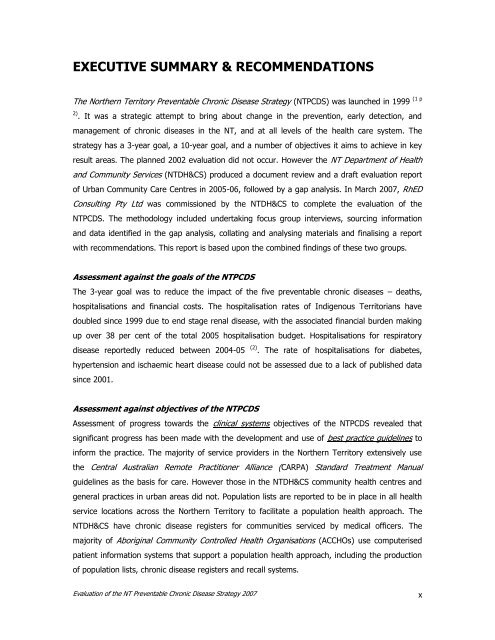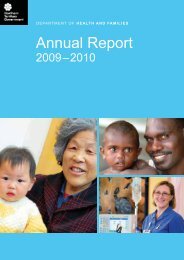PCD Strategy Evaluation 2007.pdf - NT Health Digital Library ...
PCD Strategy Evaluation 2007.pdf - NT Health Digital Library ...
PCD Strategy Evaluation 2007.pdf - NT Health Digital Library ...
You also want an ePaper? Increase the reach of your titles
YUMPU automatically turns print PDFs into web optimized ePapers that Google loves.
EXECUTIVE SUMMARY & RECOMMENDATIONSThe Northern Territory Preventable Chronic Disease <strong>Strategy</strong> (<strong>NT</strong><strong>PCD</strong>S) was launched in 1999 (1 p2) . It was a strategic attempt to bring about change in the prevention, early detection, andmanagement of chronic diseases in the <strong>NT</strong>, and at all levels of the health care system. Thestrategy has a 3-year goal, a 10-year goal, and a number of objectives it aims to achieve in keyresult areas. The planned 2002 evaluation did not occur. However the <strong>NT</strong> Department of <strong>Health</strong>and Community Services (<strong>NT</strong>DH&CS) produced a document review and a draft evaluation reportof Urban Community Care Centres in 2005-06, followed by a gap analysis. In March 2007, RhEDConsulting Pty Ltd was commissioned by the <strong>NT</strong>DH&CS to complete the evaluation of the<strong>NT</strong><strong>PCD</strong>S. The methodology included undertaking focus group interviews, sourcing informationand data identified in the gap analysis, collating and analysing materials and finalising a reportwith recommendations. This report is based upon the combined findings of these two groups.Assessment against the goals of the <strong>NT</strong><strong>PCD</strong>SThe 3-year goal was to reduce the impact of the five preventable chronic diseases – deaths,hospitalisations and financial costs. The hospitalisation rates of Indigenous Territorians havedoubled since 1999 due to end stage renal disease, with the associated financial burden makingup over 38 per cent of the total 2005 hospitalisation budget. Hospitalisations for respiratorydisease reportedly reduced between 2004-05 (2) . The rate of hospitalisations for diabetes,hypertension and ischaemic heart disease could not be assessed due to a lack of published datasince 2001.Assessment against objectives of the <strong>NT</strong><strong>PCD</strong>SAssessment of progress towards the clinical systems objectives of the <strong>NT</strong><strong>PCD</strong>S revealed thatsignificant progress has been made with the development and use of best practice guidelines toinform the practice. The majority of service providers in the Northern Territory extensively usethe Central Australian Remote Practitioner Alliance (CARPA) Standard Treatment Manualguidelines as the basis for care. However those in the <strong>NT</strong>DH&CS community health centres andgeneral practices in urban areas did not. Population lists are reported to be in place in all healthservice locations across the Northern Territory to facilitate a population health approach. The<strong>NT</strong>DH&CS have chronic disease registers for communities serviced by medical officers. Themajority of Aboriginal Community Controlled <strong>Health</strong> Organisations (ACCHOs) use computerisedpatient information systems that support a population health approach, including the productionof population lists, chronic disease registers and recall systems.<strong>Evaluation</strong> of the <strong>NT</strong> Preventable Chronic Disease <strong>Strategy</strong> 2007x
















